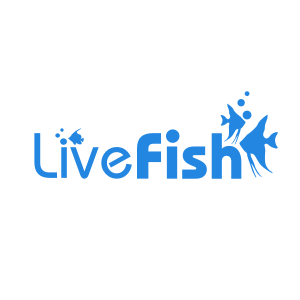Blue Ribbon Eel - Medium
This brightly coloured species of eel will make an exciting addition to your tank if you feel like you're up to the challenge. The best part is that it's better to keep more than one of these amazing creatures in the same aquarium.
The Blue Ribbon Eel starts out its life covered in black with a distinctive yellow dorsal fin and male reproductive organs. As it matures the body will gradually turn a vibrant shade of neon blue along with its face changing to yellow to match its fin. Further along its life cycle, it will transform into a female and its body will develop a yellowish-green tinge.
As mentioned above this species is a hermaphrodite and all will start their lives as males and later develop into females when needed. It is extremely difficult to breed these fish in captivity and they have only been observed spawning in an aquarium on one occasion.
Many people come across many difficulties when attempting to keeps these eels. If you're up to the challenge then the rewards and satisfaction from keeping these wonderful animals is endless.
These eels are found all over the Indo-Pacific region ranging from Southern Japan to East Africa and French Polynesia all the way down to New Caledonia. They live a secretive life mostly buried in the sand around reefs and lagoons with only their heads visible. They have been seen at depths down to 68 metres. Juveniles normally are found on their own, but the adults have been noticed to share areas and even individual hideouts.
Tank Recommendations for the Blue Ribbon Eel
The smallest tank size for this species is 210 litres and should be at least 1.2 metres long. You will need a solid tank lid to prevent them from escaping and an efficient air pump to avoid carbon dioxide buildup. Ensure a moderate amount of water movement especially near to the openings of their hideouts. These fish love darkness so any lighting setup is acceptable as long as you create hiding places for the eel to live in. The easiest way would be to bury PVC pipes into the sand substrate with curved open ends sticking out. The Blue Ribbon Eel will do well in both fish only and reef environments as long as there is live rock present.
Suitable Tank Buddies
Unlike other species, these eels will thrive when kept in a group of 2 or 3 due to their feeding habits. Be aware that they will attempt to eat small colourful fish so only add these if intended as food. They are semi-aggressive in nature but will mostly leave other fish alone as long as they don't see them as food.
Usually Compatible
Grunts, Groupers and large Angelfish are great options to combine with eels. Pufferfish and Lionfish shouldn't cause any problems either. Other wonderful choices for tank buddies are Tangs and Snappers. Eels will also leave live corals well alone and may in fact be beneficial due to the movement of the bottom substrate.
Sometimes Compatible
Species which can sometimes be problematic are Rays, Triggerfish and Wrasses. Hogfish and Squirrelfish should have an eye kept on them too. Eels will sometimes prey upon smaller fish so take care when adding any new species that it is sufficiently sized.
Rarely Compatible
Any species of small colourful fish here is a no-go. Sharks are to be avoided as well.
Feeding your Blue Ribbon Eel
These eels are carnivores in the wild and live on a diet of very small fish that mistakenly swim past their hideout opening. As such their captive diet should consist of only fish flesh and herein lies the difficulty. They will only eat live fish when first introduced to the tank. When keeping one eel alone it will more than likely not eat, but with two or more they will start a feeding frenzy and you'll find it much easier. Offer them one live fish a day, to begin with, such as colourful red guppies or small goldfish. Then slowly convert them to taking a dead fish of the same type from some tongs or a grabber which you can use to 'wave' the fish near the entrance to its hideout. Progressively switch them over to marine flesh and feed them once every other day until they are full.
| Scientific Name | Rhinomuraena quaesita |
|---|---|
| Care Level | Hard |
| Common Names | The Blue Ribbon Eel is also known as the leaf-nosed moray eel and the Bernis eel. |
| Diet | Carnivore |
| Fish Family | Muraenidae |
| Lifespan (years) | 4 |
| Max. Length (cm) | 120 |
| Min. Tank Volume (l) | 210 |
| Origin | Indo-Pacific |
| Reef Safe | Yes |
| Sociability | Semi-aggressive |
| Venomous | No |
| Water Conditions | 22 - 28°C, dKH 8-12, pH 8.1-8.4, sg 1.023-1.025 |


